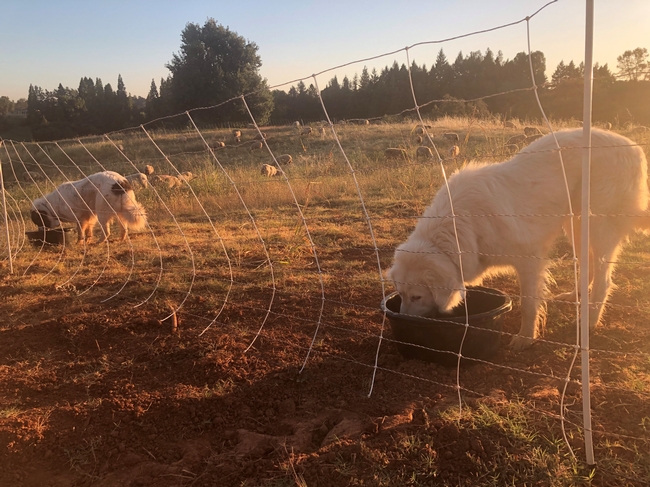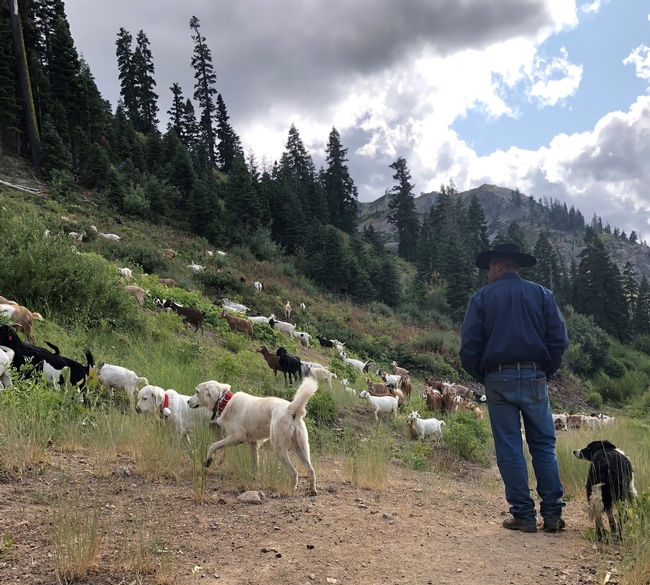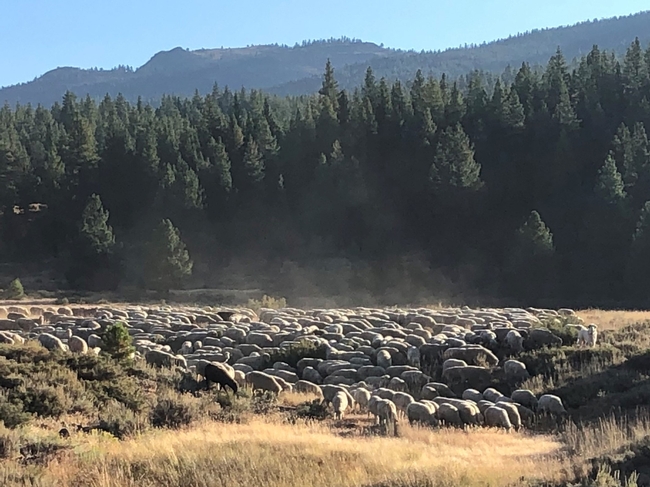Like any livestock management tool, livestock guardian dogs come with both costs and (hopefully) benefits. Some of these are easily calculated - for example, through today, we've spent $624.70 on dog food and veterinary costs related to our livestock guardian dogs this year. We currently have 3 dogs (Bodie, a 3-year-old I purchased as a pup for $350; Elko, a 2-year-old given to me as a pup; and Dillon, a 9-month-old pup purchased for $500). Some of the costs and benefits are less easily calculated, however; how do I know how many sheep didn't die because we had dogs with them? What is the value of my own peace of mind? A recent paper by Dr. Ellen Bruno (Cooperative Extension specialist in agriculture and resource economics at UC Berkeley) and Dr. Tina Saitone (CE specialist in agriculture and resource economics at UC Davis) sheds new light on these questions. Read the complete paper here.
Using data from the University of California's Hopland Research and Extension Center, Bruno and Saitone estimated that dogs reduced lambs lost to coyotes by 43% each year; ewe losses were reduced by 25%. The authors calculated the present value of these prevented deaths over the 7-year useful life of the dogs to be $16,200 (present value calculations were based on the market value of the lambs as well as the value of running-age ewes). Their model was based on using one dog per 100 ewes (more on this below).
On the cost side, the authors included initial purchase of pups, dog food (and labor associated with feeding the dogs), veterinary costs, and dog replacement costs. Labor costs, as they note, are largely dependent on the type of production system - Hopland's labor costs are probably much higher than the typical commercial operation. Using net present value analysis, Bruno and Saitone found that the costs of Hopland's livestock guardian dogs exceeded the benefits (in the value of lambs and ewes not killed by predators) by $13,412 over the seven-year analysis period. In other words, the dogs didn't pay their own way.
Bruno and Saitone offer several important caveats when interpreting these results. First, many ranchers report that dogs eliminate predation entirely (which has been our own experience). If this had been the case at Hopland, the benefits would have exceeded the costs of using dogs by over $12,000. Second, labor-related expenses associated with dogs can be difficult to quantify. In our operation, feeding the dogs is part of our daily check of fences and sheep - we see the sheep every day whether we have dogs with them or not. We charge about 5 minutes per day to feeding 3 dogs - even if I pay myself $20 per hour for this work, our "dog" labor amounts to $371 per dog annually. Hopland, on the other hand, reported labor costs of nearly $1,600 per dog per year. Finally, the authors note that lamb and ewe prices may (and usually do) change from one year to the next - and sometimes dramatically. Sheep values can alter the cost:benefit ratio.
Skeptics might wonder, "Even if you use dogs, if you're not experiencing any predator losses, maybe there aren't any predators around." My ongoing research into livestock guardian dog behavior suggests that there are ALWAYS predators around where small ruminants are grazing (whether on rangeland or irrigated pasture). Using trail cameras, we frequently "capture" coyotes, foxes, and bobcats within 10-15 feet of our sheep paddocks. Interviews with sheep- and goatherders working in the Sierra Nevada indicate that coyotes are heard - and often seen - every night near sheep and goat bed grounds. Though we see them less frequently, we know there are mountain lions and black bears in the vicinity of these operations. The predators are there - the dogs must be at least partly responsible for the lack of predator losses!
As I've written previously, the number of dogs used by producers can vary greatly - from one producer to the next, and from one season to the next on the same operation (see How Many Dogs?). One of the bands of sheep I'm observing near Truckee is guarded by a single dog (band is roughly 1,000 ewes - this scenario is significantly more cost effective than the 1 dog per 100 ewes ratio used in Bruno and Saitone's model). This ratio works because the band is comprised of mature ewes without lambs - and because the predators have plenty of other prey at this time of year. Once this band moves back to Los Banos to lamb on alfalfa stubble later this fall, the dog-to-sheep ratio will increase.
In my experience, peace of mind for the shepherd (or goatherd) can be a significant (if qualitative) benefit. My friends Brad Fowler and Nathan Medlar recently started a targeted grazing project at Squaw Valley Ski Resort north of Lake Tahoe (see Watching Other Dogs). They started the project without livestock guardian dogs (mostly to avoid conflicts with recreationists). They are herding the goats on the ski slopes during the day and penning them at night near their camp (a tent on the side of the mountain). Brad reported that neither they nor the goats slept at all on the first night - the coyotes kept the goats stirred up even though they were protected by electric fence. Brad and Nathan added two dogs on the second day - which relaxed the goats (and the goatherds). Brad reported both herders and livestock slept soundly on the second night.
Finally, research at the U.S. Sheep Center in Dubois, Idaho, found "that ewes grazing with accompanying LGD will travel greater daily distances compared with ewes grazing without LGD accompaniment. As a result of traveling greater distances, ewes may also be exposed to more and varied foraging opportunities." See Webber et al. 2015 for the complete study. To me, this suggests that dogs may make our grazing operations more efficient - allowing us to access forage that would otherwise not get grazed by unprotected livestock. This increased grazing efficiency can reduce our supplemental feed costs.
From my perspective, perhaps the most important part of Bruno and Saitone's work comes at the end of the paper:
"Sheep producers who are considering the purchase of LGDs, or those who already have LGDs and are interested in their return on investment, need a few pieces of data to make this determination. Market lamb and ewe prices are typically well known to producers and can be used, in conjunction with efficacy rates from this study, to estimate the benefits of LGDs.
"On the cost side, producers would need to make some logical forecasts about the time required to maintain LGDs, given their operation specifics.... Also, using guidance from the literature included herein, producers could calculate the likely dog cull and mortality costs of the LGD's useful life."
Ultimately, the success of any livestock protection tool (including lethal control) is highly variable depending on operator characteristics and environmental conditions. Dogs work in our operation because we see the sheep every day and because they are our only option for protecting lambing ewes (we lamb on pasture without access to a lambing shed). Dogs work for the range outfit on the Tahoe National Forest as well; human presence, the vigilance of the dogs, and the stage of production during their time in the mountains virtually eliminates predator losses. And dogs work for the targeted grazing outfits I work with in the foothills and mountains; peace of mind and lack of predator losses justify the costs of keeping dogs in these operations, too.

